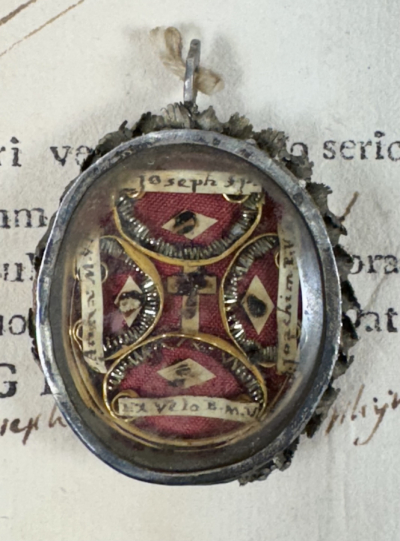The True Cross is the name for physical remnants, which, according to Church tradition, are believed to be from the cross upon which Jesus was crucified. Empress Helena, the mother of Constantine, the first Christian Emperor of Rome, traveled to the Holy Land in 326–28, where she discovered the hiding place of three crosses that were believed to be used at the crucifixion of Jesus and of two thieves, St. Dismas and Gestas, executed with him, and a miracle revealed which of the three was the True Cross. Fragments of the Cross were broken up, and the pieces were widely distributed; in 348, in one of his Catecheses, Cyril of Jerusalem remarked that the "whole earth is full of the relics of the Cross of Christ." Most of the very small relics of the True Cross in Europe came from Constantinople after the city was captured and sacked in 1204 during the Fourth Crusade. They were carved up by the present bishops and divided with other very precious relics among the knights; who, after their return to the homeland, donated them to churches and monasteries.
According to tradition, the Veil of the Blessed Virgin Mary was worn by the Virgin as she stood at the foot of the Cross. It had been transferred in the early years of Christianity from Jerusalem to Constantinople when it was presented by the Byzantine Empress Irene to the Holy Roman Emperor Charlemagne. In 876 his descendant Charles the Bald gave the relic to the cathedral at Chartres. The Veil is kept in a golden reliquary beside the high altar and has formed the focus of many traditions throughout the centuries. It was believed to have protected the faithful down through the centuries from many dangers and evils, including famine and war, outbreaks of the plague, and the worst ravishes of the French Revolution. The veil itself is more than six meters long and made of silk. Scientific studies have shown that it is of Syrian design, of fine quality, and can be traced to the first century. Every year on 15th August, the Feast of the Assumption of Our Lady, the Veil is processed through the town of Chartres.
The earliest records of a formal devotional following for Saint Joseph date to the year 800 and reference to him as Nutritor Domini (educator/guardian of the Lord). Together with the Blessed Virgin Mary and the Child Jesus, Joseph is one of the three members of the Holy Family. Of all the saints in Christendom, the only ones of whom we possess no ex ossibus (from the bone) relics are the Blessed Virgin Mary and her husband Saint Joseph. This lack of bodily relics is attributed to the Assumption of the Virgin Mary into heaven body and soul, which is one of the great Marian Dogmas of the Church. The same reasoning is applied to lack of bodily relics of Saint Joseph, Virgin-Father of Christ and Chaste Spouse of Mary. Saint Joseph is the patron saint of a number of cities, regions and countries, among them the Americas, Canada, China, Croatia, Mexico, Korea, Austria, Belgium, Peru, the Philippines and Vietnam, as well as of families, fathers, expectant mothers (pregnant women), travelers, immigrants, house sellers and buyers, craftsmen, engineers, and working people in general.
Saint Anne was the mother of Mary and grandmother of Jesus according to apocryphal Christian and Islamic tradition. She is a holy patron of Canada, carpenters; childless people; equestrians; grandparents; homemakers/housewives; lacemakers; lost articles; Fasnia (Tenerife); Mainar; Detroit; miners; mothers; moving house; old-clothes dealers; poverty; pregnancy; seamstresses; stablemen; sterility; mothers; and children.
Saint Joachim of Nazareth was the husband of Saint Anne and the father of Mary, the mother of Jesus, according to the Catholic, Orthodox, and Anglican traditions. The story of Joachim and Anne first appears in the apocryphal Gospel of James. He is a holy patron of fathers, grandfathers and the island of Poerto Rico and his feast day is July 26.










 Поменять язык на русский
Поменять язык на русский 